
|
 |
"Infection
Control for Viral Haemorrhagic Fevers
In the African Health Care Setting"
Annexes
13-16
| Annex
13 Community Education Materials |
 |
| Examples
of posters used to provide information to family members of Ebola
patients. Kikwit, 1995. |
|

Avoid contact
with patient's blood, urine and vomit.
|
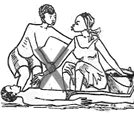
Do not touch
or wash the bodies of deceased patients.
|
|
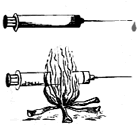
Burn needles
and syringes immediately after use.
|

Use gloves
to handle the patient's clothing. Boil soiled clothing before washing
it.
|
|
Examples
of posters or teaching aids for viral haemorrhagic fevers
|
|
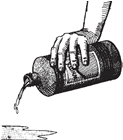
-Protect yourself.
-Never touch urine, blood, vomit from a patient with fever.
-Wash spills with bleach solution or soap and water.
|
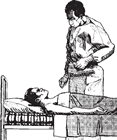
To prevent
transmission of Lassa fever, wear a gown, gloves and mask.
|
|
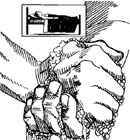
Wash your hands
if you take care of a patient with fever.
|
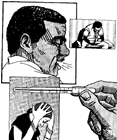
In addition
to fever, Lassa fever patient may have: sore throat, back pain,
cough, headache, red eyes, vomiting, or chest pain.
|
|
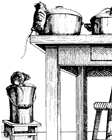
To prevent
Lassa fever, keep your food and water covered.
|
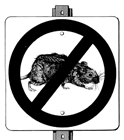
There is no
injection or vaccine to prevent Lassa fever. To prevent Lassa fever,
we must prevent its spread by rats.
|
|
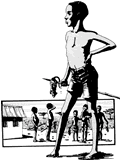
You can get
Lassa fever by touching, playing with or cutting up a rat's dead
body.
|
| Annex
14 Conducting In-Service Training for VHF Isolation Precautions |
 |
In-service training
for VHF Isolation Precautions should be ongoing. Provide training about
VHF Isolation Precautions during supervisory visits, staff meetings or
conferences. Also use other channels such as newsletters, bulletins and
job-aids to provide health facility staff with information and reinforce
the use of VHF Isolation Precautions.
Training in skills
is most effective if health staff receive information, see examples, and
have an opportunity to practice the skills they are learning. Make sure
that training sessions for each topic include relevant examples and opportunities
for meaningful practice.
Conduct training
sessions in small groups with each category of health worker.
- Present information
with charts, pictures, posters or information written on a flipchart
or chalkboard. Use drawings from this manual to illustrate the topic
you are presenting.
- Give examples
of the skills you would like the health staff to use. For example, demonstrate
the steps for handwashing as you explain aloud what you are doing.
- Provide the materials
and supplies that health staff need to practice the skill. For example,
provide two buckets of clean water, soap and clean, one-use towels.
Ask health workers one at a time to practice washing their hands.
Ask for feedback from the rest of the group about what was done well
and where improvement is needed.
- Provide feedback
to the health staff and answer questions. Conclude the training
by summarizing the steps presented in the session. Provide a job-aid
or handout to tape on a wall to remind health facility staff about the
skills they learned in the session.
- Routinely monitor
supplies and equipment to make sure that the supplies for doing the
desired skill are available. During supervisory visits, be sure to acknowledge
when you see health staff using the skills well. When problems occur,
find out what has caused them, and take steps to solve them so that
health staff can continue to use the practices consistently.
The following is
a sample agenda for in-service training. It describes how to include topics
about VHF Isolation Precautions during monthly staff meetings. Adapt it
to the schedule for your health facility.
| Month
|
VHF
Isolation Precautions Topic |
| January
|
1.
Disease Transmission in the Health Care Setting
2. Identifying Viral Haemorrhagic Fevers: When to Suspect a VHF
3. General Information about Standard Precautions
4. Handwashing |
February
|
1.
Recommended Protective Clothing for VHF
2. Practice Putting On and Taking Off Protective Clothing |
| March |
1.
Preparing Disinfectants
2. Using Disinfectants |
| April
|
1.
Selecting Disposal Sites and Planning Security Barriers
2. Building an Incinerator |
| May
|
1.
Maintaining an Incinerator
2. Preparing a Pit for Burning Infectious Waste |
| June
|
1.
Safe Use and Disposal of Sharp Instruments
2. Making a Sharps Container |
| July
|
1.
Assessing Inventory of Protective Clothing
2. Identifying Items to Use When Recommended Protective Clothing is
not Available |
| August
|
1.
Sites for Isolation Area (Patient Room and Changing Room); Security
Barriers
2. Planning to Set Up an Isolation Area |
| September |
1.
Assessing Available Supplies for Isolation Area
2. Identifying Items to Use When Recommended Supplies are not Available |
| October |
1.
Selecting and Training Caregiving Family Members: VHF, Protective
Clothing |
| November |
1.
Using VHF Isolation Precautions during Patient Care
2. Disinfecting Thermometers, Stethoscopes and Blood Pressure Cuffs
3. Disinfecting Used Needles and Syringes |
| December
|
1.
Procedures for Responding to Accidental Exposures
2. Standard Precautions -- Especially Handwashing after Examining
Patients with Fever |
| Annex
15 Local Resources for Community Mobilization and Education |
 |
Section 8 of this
manual describes how to develop community education in an urgent situation.
The first step is to identify key community resources such as groups who
know the community and already have access to it. Information about each
key community resource can be recorded on the following chart. Use the
chart as a reference to identify appropriate community resources that
can be called upon when a VHF occurs.
Local Resources
for Community Mobilization and Education
Organization
or Group |
Expertise |
Representative
or
Leader and
Locating
Information |
Human
Resources |
Available
Equipment |
Contacted? |
Task
Assigned |
| |
|
|
|
|
|
|
| |
|
|
|
|
|
|
| |
|
|
|
|
|
|
| |
|
|
|
|
|
|
| |
|
|
|
|
|
|
| |
|
|
|
|
|
|
| Annex
16 International and Regional Contacts |
 |
| SWITZERLAND |
World
Health Organization (WHO)
Division of Emerging and other Communicable Diseases Surveillance
and Control (EMC)
Dr David L. Heymann
20 Avenue Appia, CH-1211 GenËve 27, Switzerland
Tel: 41-22-791-2660/41-22-791-2661
Fax: 41-22-791-4198
E-mail: HEYMANND@WHO.CH |
| ZIMBABWE |
WHO
Regional Office for Africa
Dr D. Barakamfitiye
Director, Prevention and Control of Diseases
Medical School, C Ward, Parirenyatwa Hospital, Mazoe Street
P.O.Box BE 773, Belvedere, Harare, Zimbabwe
Tel: 1-407-733-9236
Fax: 1-407-733-9360
E-mail: BARAKAMFITIYED@HTSD.COM at INET
Dr A. Ndikuyeze, Regional Adviser, Prevention and Control of Diseases
Medical School, C Ward, Parirenyatwa Hospital, Mazoe Street
P.O.Box BE 773, Belvedere, Harare, Zimbabwe
Tel: 1-407-733-9240
Fax: 263-479-1214
E-mail: NDIKUYEZEA@SERVER.WHOAFR.ORG |
| WHO
Collaborating Centres for Viral Haemorrhagic Fevers |
UNITED
STATES OF
AMERICA |
Centers
for Disease Control and Prevention (CDC)
National Center for Infectious Diseases
Division of Viral and Rickettsial Diseases
Special Pathogens Branch
1600 Clifton Road, MS G-14
Atlanta, Georgia 30329-4018, USA
Telephone: 1-404-639-1115
Fax: 1-404-639-1118
E-Mail: CJP0@CDC.GOV |
UNITED
STATES OF
AMERICA |
US
Army Medical Research Institute of Infectious Diseases
(USAMRIID)
Fort Detrick, Maryland 21702-5011, USA
Telephone: 1-301-619-4608
Fax: 1-301-619-4625 |
CENTRAL
AFRICAN
REPUBLIC |
Institut
Pasteur de Bangui
Boite Postale 923
Bangui, Central African Republic
Telephone: 236-614-576
Fax: 236-610-109 |
| FINLAND
|
University
of Helsinki
Haartman Institute
Department of Virology
P.O.Box 21
SF-Helsinki, Finland
Telephone: 358-0-434-6490
Fax: 358-0-434-6491 |
| FRANCE |
Institut
Pasteur ‡ Paris
28, rue du Dr Roux
75724 Paris Cedex 15, France
Telephone: 33-1-4061-3088
Fax: 33-1-4061-3151 |
| GERMANY |
Philipps-University
Institute of Virology
Robert-Koch-Str. 17
D-35037 Marburg, Germany
Telephone: 49-6421-28-6253
Fax: 49-6421-28-8962 |
| KENYA |
Kenya
Medical Research Institute
Mbagathi Road
P.O.Box 54628
Nairobi, Kenya
Telephone: 254-2-722-541
Fax: 254-2-725-950 |
| NIGERIA |
University
of Ibadan
College of Medicine
Department of Virology
Ibadan, Nigeria |
| SOUTH
AFRICA |
National
Institute for Virology
Special Pathogens Unit
Private Bag X4
Sandringham 2131, Zaloska 4
Republic of South Africa
Telephone: 27-11-882-9910
Fax: 27-11-882-0596 |
| SWEDEN
|
Swedish
Institute for Infectious Disease Control
S-105 21 Stockholm, Sweden
Telephone: 46-8-735-1300
Fax: 46-8-735-6615 |
| UNITED
KINGDOM |
Centre
for Applied Microbiology and Research
Division of Pathology
Porton Down, Salisbury, United Kingdom
Telephone: 44-198-061-2224
Fax: 44-198-061-2731 |
|
 |
 |
 |
| Infection
Control For VHFs Manual |
|
|
 |
 |
|
| Sections
on this page |
|
|
 |
 |
|
|
 |
